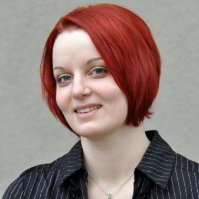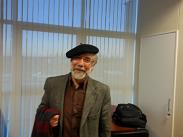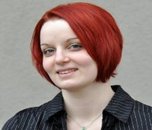Day 1 :
Keynote Forum
Marina Zueva
Moscow Helmholtz Research Institute of Eye Diseases, Russia
Keynote: Nonlinear impacts on human brain for recovering of physiological and mental activity and for rehabilitation in extreme ambient conditions
Time : 09:00-09:40

Biography:
Marina Zueva is a Professor of Pathophysiology. She completed her Graduation at Lomonosov Moscow State University; PhD and Biological Science Doctorate at Moscow Helmholtz Research Institute of Eye Diseases. Currently, she is the Head of the Division of Clinical Physiology of Vision at Moscow Helmholtz Research Institute of Eye Diseases. She is a member of International Society of Clinical Electrophysiology of Vision (ISCEV), European Association on Vision and Eye Research (EVER) and European Society of Retina Specialists (EURETINA). She has published over 10 peer-reviewed papers in English (over 86 in Russian) and presented over 65 topics at international conferences
Abstract:
In 2015, we theoretically substantiated the hypothesis that there is the intimate link between the complexity of neural connections, nonlinear dynamics of physiological processes in the brain and the nonlinear characteristics of sensory environmental cues. The impact throughout the person's life of visual and other sensory environmental cues of a complex spatiotemporal structure is necessary for normal maturation, development, and aging of the brain. The theory associates the development and maintenance of healthy structure and activity of the neural networks of the brain and retina with the complexity of visual and other signals of the environment affecting the person, with his life experience of nonlinear stimulation. Hence, the need to maintain healthy fractal dynamics during life, using the natural and the artificial fractal cues when the dynamics of the brain’s function is disordered, or when there is a simplification of environmental stimuli. The use of fractal stimulation and other nonlinear effects can promote recovery of the function of the brain and the retina including neurodegenerative diseases, acting through the reactivation of neuroplasticity. Nonlinear stimulation therapy in medicine must become an essential element of therapeutic strategies for activating neuroplasticity and enhance the effectiveness of the treatment of some pathological conditions: glaucoma, retinitis pigmentosa, Alzheimer's disease, Parkinson's disease, sleep disorders, and amblyopia. Technologies of nonlinear impacts may be applied in various other pathological conditions, which are accompanied by the simplification of a temporal pattern of the brain activity and the emergence of deterministic or stochastic dynamics of fluctuations of various physiological functions. For the recovery after brain injuries and strokes, it is possible to use nonlinear techniques of stimulation therapy in the offices (centers) on rehabilitation and psychological training. Application of non-linear technologies is also prospective in following areas: Gerontology- under normal physiological human aging, the loss of the memory and some other cognitive functions occurs. Nonlinear stimulation techniques may be useful for normalization and long-term preservation of cognitive functions and intelligence of older people, promoting mental longevity; sport- nonlinear stimulation techniques may be helpful for increasing and rapid recovery of mental and physical performance in severe physical or psychological stress in athletes and; work in the extreme environment- nonlinear stimulation techniques may be useful for restoration and enhancement of cognitive function, preservation of critical thinking in the extreme conditions of work and stress situations, including long-term space missions.
Keynote Forum
Eva Kudova
Czech Academy of Sciences, Czech Republic
Keynote: Neuroactive Steroids as Neuroprotective Agents
Time : 10:20-11:00

Biography:
Abstract:
Neuroactive compounds are synthetic analogues of neurosteroids that are naturally synthesized in the nervous tissue from cholesterol or steroidal precursors from peripheral sources. The neuroprotective effect of neurosteroids or neuroactive steroids is supposed to be realized via rapid, non-genomic mechanism. Multiple studies have been already performed to demonstrate efficacy of neurosteroids in the treatment of various central and peripheral nervous system diseases (e.g. ischemia, seizures, neurodegeneration, etc.). However, the mechanisms of neuroprotective effect of neuroactive steroids remain unclear and accumulating evidence indicate that this process can be regulated in multi-target manner. Moreover, neuroprotection include mechanisms protecting against neuronal injury/damage or degeneration according to acute or chronic origin of pathological process. As such, research targeting design and development of neuroprotective steroids with therapeutic potential is extremely challenging. In the last decade, we have synthesized a library of neuroactive steroids that act as potent negative modulators of N-methyl-D-aspartate receptors (NMDARs) that play significant role in learning and memory. Also, we have shown that these compounds do exhibit strong neuroprotective effect in in vivo models. Currently, our main avenue of investigation is development of an in vitro multiplexed screening platform to identify molecules with strong neuroprotective effect. Therefore, we have developed a methodology for neuroprotective effect screening in the model of glutamate/NMDA-induced excitotoxicity on embryonic cortex neurons. We conclude that pretreatment with our neurosteroids significantly reduced acute NMDA/L-glutamic acid excitotoxicity mediated by Ca2+ entry and consequent ROS release and caspase-3 activation. Compounds 6 (IC50=5.8 µM), 7 (IC50=12.2 µM), 9 (IC50=7.8 µM), 13 (IC50=1.1 µM) and 16 (IC50=8.2 µM) attenuated glutamate-induced Ca2+ entry more effectively than memantine (IC50=18.9 µM). Moreover, compound 13 was more effective than MK-801 (IC50=1.2 µM). This drop in Ca2+ level resulted in corresponding reactive oxygen species suppression and prevented glutamate-induced caspase-3 activation.
Keynote Forum
Deepa Vinoo
New York City Health and Hospitals, USA
Keynote: Music and Memory in Memory Care Units Resulted in Reduction of Unnecessary Usage of Antipsychotics, Falls and Physical Altercations.
Time : 11:20-12:00

Biography:
She is the assistant Director of Nursing,(Director of Memory Care ), NYC Health and Hospitals
As director of the Memory Care Unit at NYC Health and Hospitals/Coler, Deepa Vinoo leads an interdisciplinary team that utilizes innovative techniques to effectively, holistically, and compassionately care for residents diagnosed with dementia. She has been leading award winning project “ Reduction of Antipsychotics in Dementia Related Behavior’. Vinoo has spearheaded ongoing training that has updated Coler’s caregiving approach to align with Alzheimer’s Association best practices and has helped 95 percent of her team to earn National Council of Certified Dementia Care Practitioners certification. “Music & Memory” is a standout program led by Vinoo at Coler; this program uses familiar music to reach behind the veil of dementia in order to draw out persons hidden behind the disability and reengage them with the world. Through this and other advanced treatment programs led by Vinoo, Coler has achieved significant reduction in antipsychotic medication administered to residents diagnosed with dementia, increased engagement and satisfaction among residents’ families, and fostered better interaction between residents and staff – a relationship vital to improving successful long-term care.
With more than 20 years of experience as a nursing instructor administrator and clinician, Vinoo holds an MSN degree in Psychiatric Nursing. Ms.Vinoo is a board certified gerontological Nurse and a Certified Dementia Care Practitioner.
Abstract:
Behavioral disturbances among patients with dementia, including agitation, aggression, and psychosis, form a constellation of symptoms referred to as behavioral and psychological symptoms of dementia (BPSD). These impact heavily on resident’s quality of life, caregiver stress, and management options for the team.
In the United States, the National Partnership to Improve Dementia Care established a new national goal of reducing the use of antipsychotic medications in long-stay nursing home residents by providing person centered Comprehensive interdisciplinary care. Implement National partnership’s goals and CMS regulatory standards to improve Dementia Care. Improve the quality of care of residents with diagnosis of Dementia by providing person centered memory Care programs. Reduce falls and physical altercations by meaningful engagement. Reduce the usage of antipsychotics by implementing non pharmacological behavior management in Dementia related behavior. This study was conducted in four Memory care units with 108 residents at an 815-bed long-term nursing care facility. All residents in Memory Care Units from last quarter of 2014 to 3rd quarter of 2016 were individually assessed for Physical Altercations, fall, Usage of Music and Memory and Usage of Antipsychotics.
- Neurochemistry
Location: Meeting Hall 4 & 5
Session Introduction
Rodrigo Pascual
Avenida Universidad, Chile
Title: Antenatal glucocorticoid administration significantly reduced the immunohistochemical expression of synaptophysin and locomotor behaviour in adolescent rats
Time : 12:40-13:00

Biography:
Rodrigo Pascual has completed his MSc and PhD at Universidad Autónoma de Barcelona School of Medicine (Spain). He has published more than 20 papers in reputed journals and four books.
Abstract:
Several studies have indicated that abnormal prenatal changes in the circulating glucocorticoids (GCs), induced by either maternal stress or exogenous GC administration, significantly alter the development of Purkinje cell (PC) dendrites and synaptogenesis. However, it is unknown whether a single course of a therapeutic dose prenatally GCs alters the major synaptic vesicle protein synaptophysin (Syn). Thus, in this study we analysed whether a single course of prenatally administered betamethasone phosphate (BET) in pregnant rats changes the immunohistochemical expression of Syn along with locomotor behaviour (rota rod-test). The data obtained showed that in utero BET exposure resulted in a significant immunohistochemical underexpression of Syn and a significant reduction in locomotor behaviour during late postnatal life. In conclusion, our previous and current works indicate that prenatal BET administration significantly modify the cerebellar development. Of note, these and other experimental data do not portend to minimize the beneficial effects of BET administration when there is a risk of respiratory distress/bronchopulmonary dysplasia in preterm infants.
Ali H Alwadei
National Neuroscience Institute, Saudi Arabia
Title: Loss-of-function mutation in RUSC2 causes intellectual disability and secondary microcephaly
Time : 13:40-14:00

Biography:
Ali H Alwadei currently works at Pediatric Neurology Department, National Neuroscience Institute, King Fahad Medical City, PO Box 59046, Riyadh 11525, Saudi Arabia.
Abstract:
Intellectual disability is seen in up to 1% to 3% of the general population, and is often dichotomized into syn- dromic and non-syndromic forms.1 A genetic aetiology accounts for about 25% to 50% of cases, with up to 700 monogenic mutations identified so far.2 Recent advances in genetic testing have allowed the identification of an ever- increasing repertoire of genes causing intellectual disabil- ity.2 Characterization of their protein products has shed light onto the diverse biological pathways affected in this important neurological disease that results in significant impairment in cognitive and adaptive behaviour, and which has important medical and social implications.3Aberrancies in synaptic vesicular transport and intracel- lular protein trafficking have been highlighted among the various biological pathways reported to cause intellectual disability.3 Included in these are mutations in genes coding for Rab proteins (rabaptins), a group of small Ras GTPases that have been shown to play an important role at different levels of the cellular trafficking pathway.4–6 Although over 60 Rab proteins have been identified so far, only a few have been implicated in human disease, including in patients with intellectual disability with or without associ- ated brain malformations.7,8RUSC2, officially known as RUN and SH3 domain con- taining-2, is a gene found on chromosome 9p13.3 (gene identifier [ID] 9853, Mendelian Inheritance in Man [MIM] 611053). RUSC2 codes for iporin, a ubiquitous protein with moderate to high expression in the human brain.9,10 The literature on the functions of iporin remains sparse, but there is some evidence that it interacts with Rab1b and Rab1-binding protein GM130,10 both of which are also expressed in the brain, with highest expression in dendritic spines where they appear to play an important role in synaptogenesis.So far, no mutations in RUSC2 have ever been shown to cause human disease, and no animal models disrupting this gene have been described. However, to our knowledge for the first time, we describe the clinical presentations of three patients (two male siblings and one unrelated female) with severe intellectual disability and microcephaly. Through whole-exome sequencing, all three were found to have inherited homozygous nonsense mutations in RUSC2. This report adds to the expanding landscape of genetic causes of intellectual disability, and suggests that RUSC2, probably through its interactions with Rab proteins.
Masayuki Yamashita
International University of Health and Welfare, Japan
Title: Electric axon guidance in embryonic retina: Involvement of integrins
Time : 14:00-14:20

Biography:
Masayuki Yamashita is a Professor of Physiology at International University of Health and Welfare. He completed his PhD in Department of Neurophysiology, University of Tokyo in 1986. He moved to National Institute for Physiological Sciences (Okazaki, Japan) as a JSPS Fellow and a Research Associate. In 1989, he started physiological studies of retina in Department of Neuroanatomy, Max-Planck-Institute for Brain Research. After the reunification of Germany, he moved to the Department of Physiology, Osaka University Medical School. He studied the calcium signaling systems in embryonic chick retina. Then, he moved to the Department of Physiology, Nara Medical University as a Professor (1999-2014). He has been interested in “The electrophysiological properties of neuroepithelial cells and newborn neurons”. The retina is a nice model for studying the early development of central nervous systems.
Abstract:
The axons of embryonic brain, spinal cord and retina extend along the extracellular voltage gradient towards the cathode in a process known as galvanotropism. In embryonic nervous tissues, positive direct current (DC) potentials are generated by neuroepithelial cell’s sodium transport, of which disruption results in erroneous axon path-finding, suggesting that electric fields play a pivotal role in orienting newborn axons. However, the experimental evidence was lacking for the cell surface molecule that is activated asymmetrically in an electric field. Here, it is shown that integrin activation mediates electric axon guidance. Retinal strips of chick embryos were embedded in Matrigel®, and cultured in the electric field of the same strength as that in vivo (15 mV/mm). Matrigel® contained the same extracellular matrix proteins as in the embryonic retina, laminin and collagen, to which integrins bind. Retinal ganglion cell axons extended towards the cathode. A monoclonal anti-chicken integrin antibody (TASC), which enhances integrin-ligand binding, accelerated the cathodal growth. A reduction in the extracellular free Ca2+with EGTA also enhanced the cathodal growth, which suggested that millimolar Ca2+ inhibited axon growth, and also that the influx of Ca2+ was unlikely to be essential for cathodal steering. In the presence of Mn2+, which non-specifically activates integrin-ligand binding, the axons formed local meshes. These results suggested that the inhibition of integrins by the extracellular Ca2+ underlies electric axon guidance.
Jong Wook Chang
Samsung Medical Center, South Korea
Title: The Application of Human Mesenchymal Stem Cell for Alzheimer’s Disease
Time : 14:20-14:40
Biography:
Abstract:
Various groups have presented findings that human mesenchymal stem cells (MSCs) have both immunomodulatory and trophic properties. MSCs tend to act indirectly at sites of injury or damage through the secretion of paracrine factors in vitro and in vivo. For example, our studies have been done using a transgenic Alzheimer’s disease mouse model where intraparenchymal injections of MSCs resulted in the reduction of amyloid plaque levels, anti-apoptosis, and activation of endogenous neural stem cell and also activate proteasome in neuron. In addition, efficient MSC delivery is also a significant issue for human study. By possessing a broad range of functions, MSCs hold great potential in being used as a novel treatment for various diseases including neurodegenerative disorders.
- Molecular Neurosciences and Neuro transmitters
Location: Meeting Hall 4 & 5
Session Introduction
Eva Kudova
Czech Academy of Sciences, Czech Republic
Title: S.M.A.R.T. STEROIDS Steroidal Molecules As Rapid-acting Therapeutics
Time : 16:20-16:40

Biography:
Eva Kudova has been working at Institute of Organic Chemistry and Biochemistry in Prague, Czech Academy of Sciences (IOCB) since 2002. She completed her PhD in 2009 at Charles University in Prague. Then, she worked for two years in the lab of Douglas F Covey at Washington University School of Medicine in St. Louis, Missouri, USA. Since 2011, she works at IOCB as the Project Investigator (PI) at Targeted Research Group of Steroidal Inhibitors. Her main research interest is Steroidal Chemistry. She has been working in this field for more than 10 years. Her major avenue of investigation is design and synthesis of new neuroactive steroidal compounds and structure-activity relationship studies affording NMDARs ligands.
Abstract:
Neurosteroids are compounds synthesized in the nervous tissue from cholesterol or steroidal precursors from peripheral sources. It is believed that neurosteroids execute their effects by modulating the activity of different membrane receptors, including the glutamatergic ionotropic receptors, e.g. N-methyl-D-aspartate receptors (NMDARs). The NMDARs play an important role in development, synaptic plasticity, learning and memory, however, abnormal activation of NMDA receptors have been shown to mediate neuronal degeneration/cell death. To find novel potentially beneficial drugs to treat neurological damage or neuro-degeneration is one of the most investigated areas in contemporary pharmacology and neuroscience. Therefore, we have designed and synthesized a library of SMART steroids- steroidal molecules as rapid-acting therapeutics. SMART steroids are neuroactive molecules, targeting primarily NMDARs, show neuroprotective properties and minimal side effects in animal models. Our screening pipeline currently covers physicochemical and biological properties like: Solubility (DLS); lipophilicity (logP, logD, ΔGsolv); patch-clamp recordings from HEK293 cells assessing NMDAR inhibition rates and IC50 values; caco-2 assay, treatment of glutamate and NMDA-induced neurotoxicity (survival rate, caspase-3, intracellular calcium levels, ROS); in vitro growth of postnatal neurons after neurosteroid administration; models of animal behavior (open field, elevated plus maze, forced swim test, etc.); PTZ-induced seizures; paclitaxel-induced peripheral neuropathy and; pharmacokinetic properties. Our results indicate that these compounds do afford neuroprotective effect and as such, SMART steroids may be beneficial in treatment of several neurological diseases like epilepsy, neuropathic pain, AD, PD and others. Broad patent portfolio has been developed protecting compounds, production and its use for treatment in neurology etc.
Mohamed Shaban
Cairo University, Egypt
Title: Predisposing factor for adjacent-segment failure following lumbar fixation for degenerative instability
Time : 16:40-17:00
Biography:
Mohamed Shaban is currently working at Cairo University as a special surgeon from the year 2009 to 2017. He has many research works published.This is one of the latest research he submitted to the university.
Abstract:
Object: Adjacent-segment failure is a well-known risk of lumbar fixation. The aim of this retrospective study was to identify risk factors for next-segment failure in lumbar fixation for degenerative instability.
Method: We retrospectively evaluated 122 patients who underwent of lumbar fixation for degenerative instability from 2011 to 2014 in Faculty of Medicine, Cairo University. All procedures were performed by a single surgeon. The patients with next-segment failure underwent neurological assessment, radiographic studies and sequential follow-up examinations. The mean follow-up period for this group was 30 months.
Results: 33 patients of 122 fusion procedures were performed in women who were postmenopausal. A total of 19 patients of 125 patients developed symptomatic next-segment degeneration at a previously asymptomatic level; 15 were postmenopausal women. All women were postmenopausal, and 50% received bisphosphonate drugs and calcium supplementation preoperatively for osteopenia. 20% of all patients with next-segment failure were cigarette smokers. Next-segment diseases included spondylolisthesis (52%), spinal canal stenosis due to disc herniation and/or facet hypertrophy (33%), stress fracture (12%), and scoliosis (3%). Patients may have more than one degenerative process at the next segment.
Conclusions: Postmenopausal women show the highest risk of adjacent-segment failure for patients in whom lumbar fusion with rigid instrumentation is performed to treat degenerative instability.
Getachew Alemayehu
Bahirdar University, Ethiopia
Title: Craniopagus parasiticus:Parasitic Head protuberant from temporal area of cranium: A case report
Time : 17:00-17:20
Biography:
Getachew Desta completed his Doctor of Medicine at Gondar University and has one and half years of working experience as a Lecturer at Bahir Dar University. Currently, he is a fourth year Resident in Surgery at Bahir Dar University.
Abstract:
Background: Craniopagus parasiticus is a rare medical case and it is unique unlike other cases reported from different literature. The head of parasitic twins is protruding from the temporal area of cranium. Parasitic head has two deformed lower limbs; one is too rudimentary attached to the mass; long bones of bilateral lower limbs and some pelvic bones. After dissection of the mass, the intestine was seen but no chest organs and other abdominal organs. There is also rudimentary labium but no vaginal opening.
Case Presentation: A 38-years-old multigravida (gravida V para IV) women from Amhara ethnicity referred from rural health center to referral hospital due to prolonged second state of labor at 42+1 weeks. Upon arrival, she had contraction, term sized gravid uterus, and fetal heart beat was 112. On digital pelvic examination the cervix was fully diluted, station of the head was high and the pulsating umbilical cord coming in front of the presenting part with ruptured membrane but yet in the vaginal canal. The team decided emergency cesarean section and then a live female infant weighing 4200 g was delivered. The placenta was single and normal. The APGAR scores were seven and nine at one and five min, respectively. The infant appeared to be grossly normal except the parasitic co-twin attached at the cranium. The neonate was investigated with the available investigations (CBC, X-Ray, Doppler ultrasound) and pediatric side consultation made. After a week of counseling and investigations, successful separation operation was done. During post-operative time the neonate comfortably suckling on breasts and no neurological deficit. The details of the surgery, post- operative condition & subsequent follow up will be discussed during the conference.
Conclusion: The possible etiologies of craniopagus parasiticus are still unknown due to a rarity of cases. Doctors, genetic scientists, epidemiologists and researchers continue to investigate this case as the reasons that could give clue to birth defect and to provide answer for better prognosis of cases and improve the life chances of the twins. This case will have some input in the effort to know the etiology and pathogenesis of this new borns.
Deepa Vinoo
New York City Health and Hospitals, USA
Title: Comfort Care In Dementia
Time : 17:20-17:40

Biography:
Abstract:
Paula Kiełbik
Warsaw University of Life Sciences, Poland
Title: Biodistribution and permeability of the blood-brain barrier by biodegradable ZnO nanoparticles in the living organism
Time : 17:40-18:00

Biography:
Paula Kielbik is currently a PhD student at Warsaw University of Life Sciences, Faculty of Veterinary Medicine. She completed both her Bachelor Degree and Master of Science Degree under supervision of Dr Michal Godlewski in Nanotechnology laboratory in collaboration with Polish Intitute of Physics. In her scientific work, she focused mainly on “Biodistribution of biodegradable nanoparticles in the living organism”. The main aspect of her work was transfer of nanoparticles through the organism barriers (i.e. intestinal barrier, blood-brain barrier, blood-testis barrier) by ZnO-derieved NPs in adult organism. Working as a member of a team in Nanotechnology laboratory, she was involved in the development and assessment of compherehesive methodology for the evaluation of gastrointestinal absorption, circulation and elimination from the organism of biodegradable nanoparticles.
Abstract:
Zinc oxide nanaoparticles (ZnO NPs) became promising material for numerous applications, including biomedicine. Avaible reports assessing their biodistribution present contradictory conclusions. Furthermore transfer of NPs through the blood-brain barrier has not been reported extensively. In our study, we orally administrated fluorescent. ZnO NPs doped with Europim (ZnO:Eu) to mice (n=35). After 3 h, 24 h, 7 d, 14 d or 1 m mice were sacrificed and internal organs were collected for the assessment of biodistribution and localization of NPs in the organism. For the analyses, we proposed a novel comprehensive and innovative approach. Along with the measurement of Zn concentration in organs with spectroscopy method (AAS), we performed quantitative and qualitative cytometric evaluation of collected samples. The distribution patterns of ZnO:Eu NPs within tissues were statistically assessed with scanning cytometry, while the extent of biodegradation was semiquantitatively elucidated by confocal microscopy. Results revealed very rapid and efficient uptake and distribution of ZnO:Eu NPs to key organs and tissues, also crossing physiological barriers. Spleen, as well as fat tissue were responsible for accumulation of NPs, and liver with kidney were designated for their elimination. An interesting pattern of biodistribution of NPs in the brain was also observed. Following 3 h after IG administration, we observed crossing of the blood-brain barrier by ZnO:Eu NPs and their uniform distribution in the brain. Similar observations were reported earlier for non-biodegradable ZrO2:Pr NPs and Y2O3:Eu NPs. The peek of NPs transfer to the brain seems to take place 24 h post IG with majority of NPs allocated in the areas of dense neuronal networks, limbic system and cerebellum. During following days, we observed a drop of NPs-related fluorescence. However, the association with limbic system and dense neuronal networks remained. We speculate that elimination of the NPs from the brain might be consequential of biodegradation of NPs and their efficient elimination via neuronal transport.
